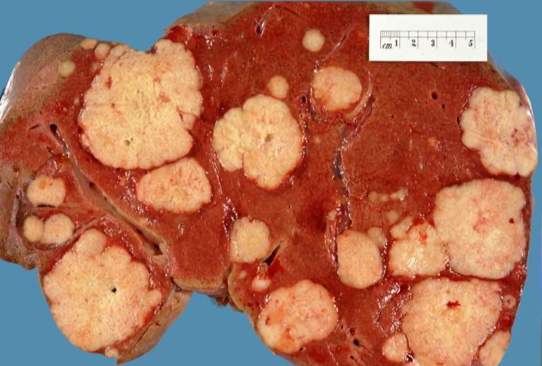Table of Contents
Overview – Liver Cancers
Liver cancers include primary hepatic tumours (most commonly Hepatocellular Carcinoma) and secondary (metastatic) liver tumours, which are far more common overall. Hepatocellular Carcinoma (HCC) typically arises in the background of chronic liver disease and cirrhosis, especially due to hepatitis B, hepatitis C, and alcohol. Conversely, metastatic deposits often originate from colorectal, breast, lung, or melanoma primaries and frequently present with systemic symptoms and hepatic dysfunction.
Hepatocellular Carcinoma (HCC) – Primary Liver Tumour
Aetiology
- Hepatitis B & C (chronic) – high risk
- Cirrhosis – regardless of cause (alcoholic, viral, haemochromatosis)
Pathogenesis
- Cirrhosis precedes HCC in nearly all cases
- Chronic inflammation → cellular dysplasia → malignant transformation
Morphology
- Single or multiple hepatic masses
- Histologically resemble hepatocytes

Clinical Features
- Symptoms:
- Fever, night sweats
- Anorexia, weight loss
- RUQ pain
- Jaundice, pruritus
- Signs:
- Hepatic encephalopathy, asterixis
- Cirrhotic liver – small, nodular
- Ascites
- Suspect HCC in deteriorating cirrhotics
Investigations
- ↑ Serum Alpha-Fetoprotein (AFP)
- LFTs – ↑ALT/AST, ↑bilirubin
- FBC – may show anaemia, ↑MCV
- Ultrasound (USS) – homogeneous mass
- CT/MRI – for staging
- +/- FNA or biopsy (if needed for diagnosis/grading)
Management
- Surgical resection – only curative option
- Chemotherapy & radiotherapy have limited benefit
- Palliative care if unresectable
Complications
- Metastasis via:
- Portal vein or hepatic vein
- Lymphatics
- Common metastatic sites: lungs and bones
Prognosis
- Poor – median survival ~6 months post-diagnosis
Liver Metastases – Secondary Liver Tumours
Aetiology
- Most commonly from:
Pathogenesis
- Haematogenous spread → liver
- Often via portal circulation or systemic blood flow
Morphology
- Multiple, well-demarcated nodules
- May be found incidentally on imaging

Clinical Features
- Symptoms:
- RUQ pain
- Anorexia, weight loss
- Nausea
- Cachexia
- Signs:
- Jaundice, pruritus
- Hepatic encephalopathy
- Fevers, night sweats
Investigations
- CT scan – diagnostic and prognostic
- LFTs – typically elevated
- FNA – to confirm diagnosis if primary is unknown

Management
- Palliative chemotherapy
- Analgesia and symptom management
- Rarely resected unless isolated and chemoresponsive
Summary – Liver Cancers
Hepatocellular Carcinoma is a major complication of chronic liver disease and cirrhosis, often presenting late with systemic symptoms and liver decompensation. Liver metastases are more common overall and often signify advanced systemic cancer. Diagnosis relies on AFP, imaging, and biopsy, while curative treatment is limited to early HCC via surgical resection. All other cases require palliative care and symptom control. For further hepatology topics, see our Gastrointestinal Overview page.